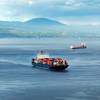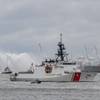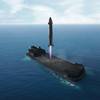Walker: Build Now, Build Many
The title of this article was the simplified (and anticipated) statement from the mouth of Allen Walker, president of the Shipbuilders Council of America (SCA), in a discussion sponsored by the Ship Operations Cooperative Program (SOCP) and held in early March at the Litton-Avondale Shipyard.
While Walker, paid to promote the U.S. industry, is understandably optimistic; he followed his simplistic proclamation with a number of sound reasons to expect an upturn in business at U.S. shipyards.
OPA 90 has long been discussed as the impetus for barge and shipbuilding boom in mid- and large-size U.S. yards. While the reality in the form of an orderbook has yet to materialize, as it is evident that owners are waiting until the last possible moment to order new tonnage, the reality in terms of the regulation are very clear: operate double hull vessels or forget about carrying petroleum products in U.S. waters. Walker notes that 30 to 40 tank barges and 15 tankers must be built by 2005, and, by waiting, owners could in fact be driving the ultimate price of the vessel up. As yards get filled, it will become increasingly difficult to secure the prime delivery slots, and the full force of demand and supply will be felt.
Doug Downey, Vice President Finance & Administration, Canal Barge Co., is responsible for the financial well-being of the 67-year-old New Orleans-based company, which employs 410 employees for the safe, efficient operation of its fleet, which includes 25 manned vessels and 529 barges.
Canal Barge specializes as a long-haul liquid cargo carrier, but is diversified in its approach and has significant business as a deck carrier, in the dry bulk market, and vessel management for third party customers.
According to Downey, the major trends shaping the industry’s business for tomorrow includes a major consolidation of both competitors and customers; an increase in the number of captive fleets for sale; a sustained push for newbuilding to replenish a rapidly aging fleet. On the latter point, Downey notes that consolidation and efficiency have helped to currently make shipyard pricing very attractive.
Walker also sees the offshore market as ripe for expansion, driven by the move to deeper waters, and the resultant need for new rigs and very large crew and supply boats to service them. SCA projects that the influx of offshore related orders will start at the end of 2001. In addition, the green light for FPSO vessels in the Gulf of Mexico will result in a significant amount of business, as there will be an need for an estimated five FPSOs and 10 shuttle tankers (two for each FPSO) by 2005.
The passenger ferry sector is also looking bright according to Walker, who noted that there are currently nine cruise ship projects in the pipeline. But he sees the brunt of business in this sector, by vessel number, coming in the passenger ferry segment, as urban planners increasingly turn to the waterways to free up road congestion.
Finally, containership construction is also considered a prime target of U.S. shipbuilders, as the U.S. containership fleet of about 100 vessels is a rather old fleet, and much of it will be due for replacement in the next 15 years. In addition, the move towards increasingly larger containership – and the relatively small number of ports capable of handling them – should result in a significant feeder containership boom.












